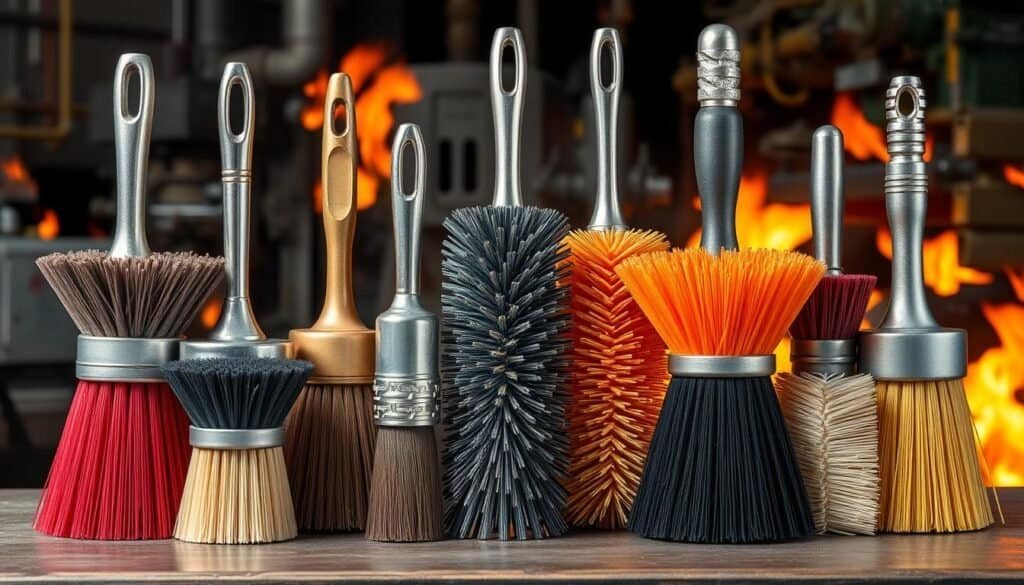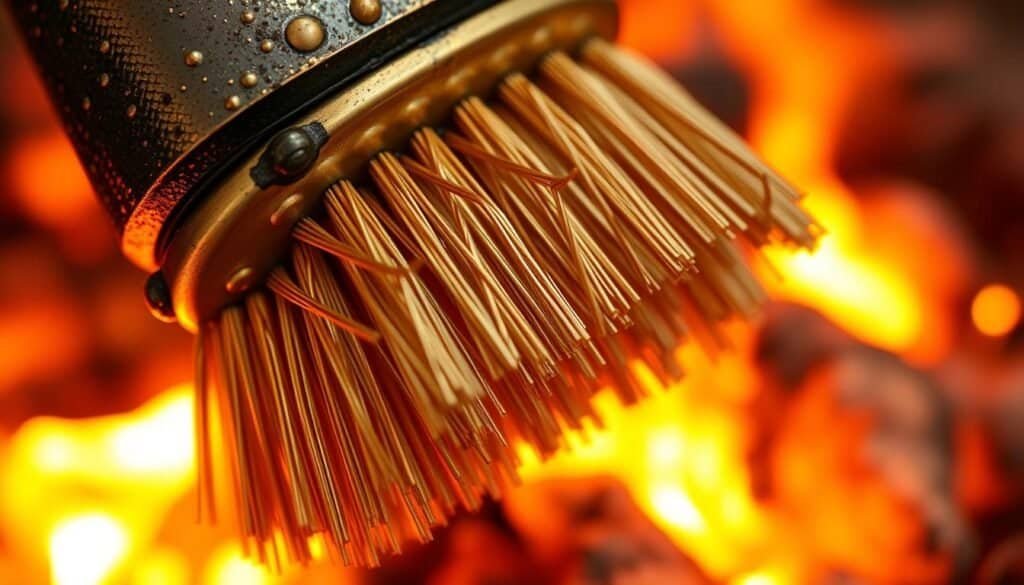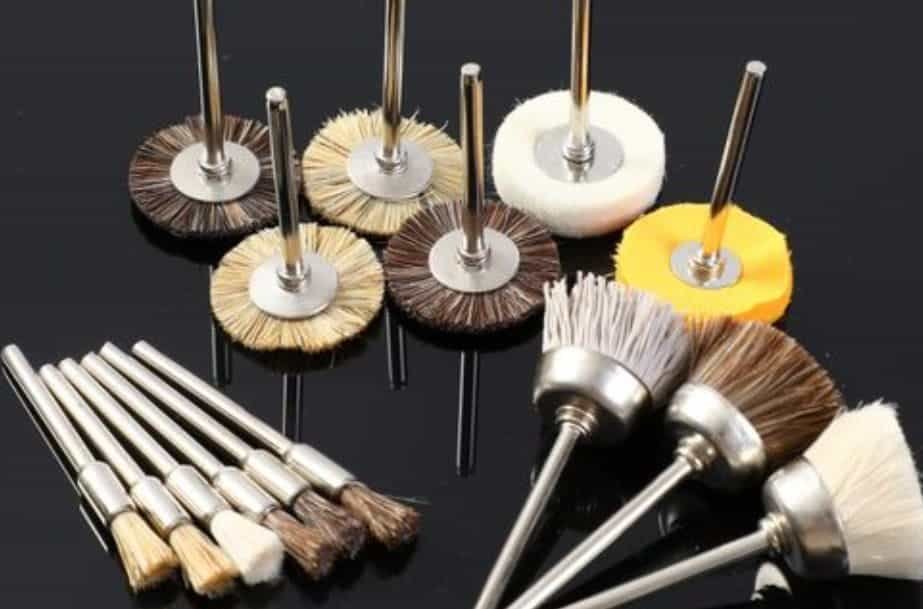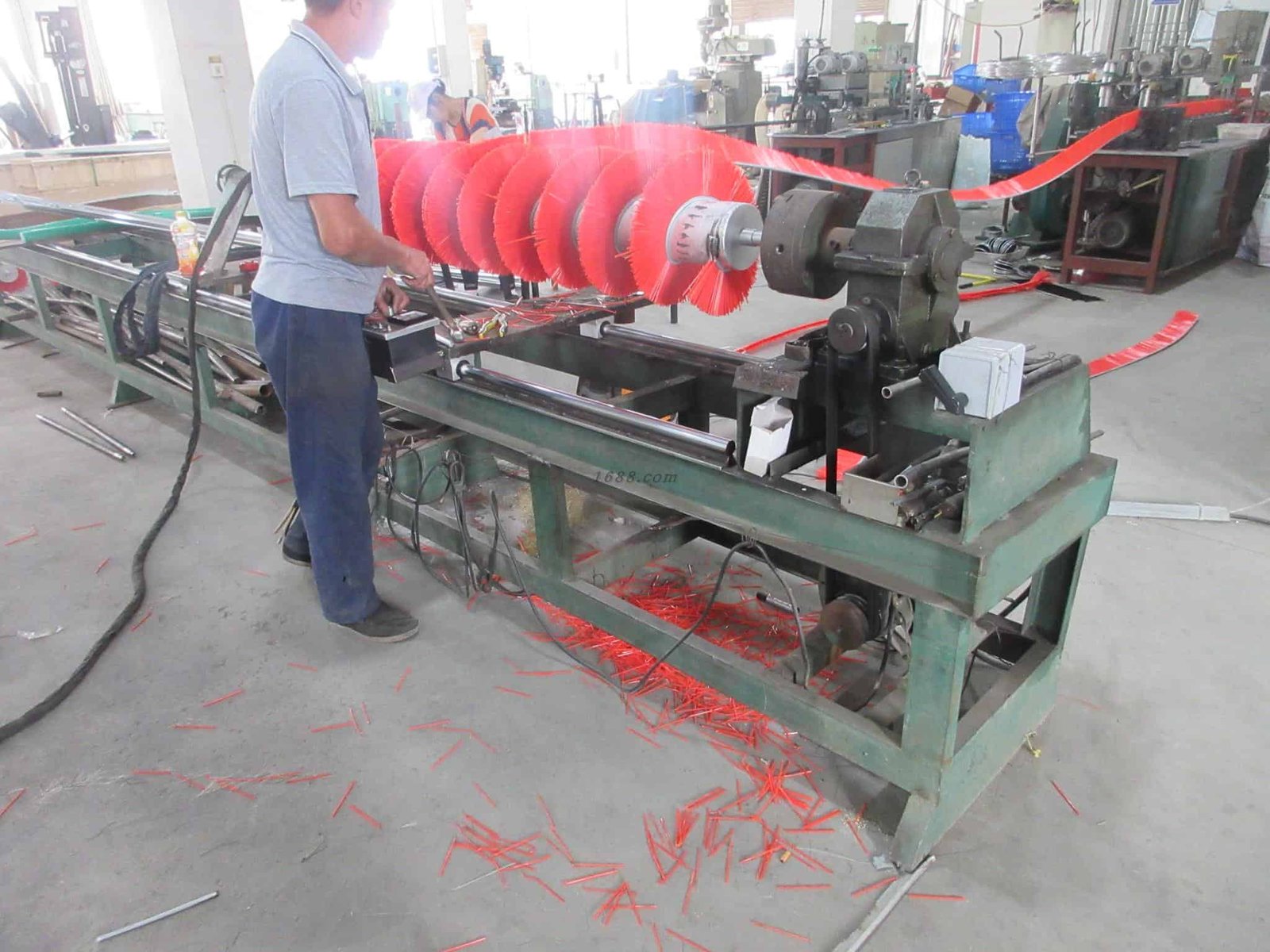Choosing the right brush for high-temperature jobs is key. There are many bristle materials to pick from. It’s hard to know which one can handle the heat and perform well.
In this article, we’ll explore high-temperature brushes. We’ll look at the main features of different heat-resistant bristles used in industrial settings.

We’ll compare popular materials like stainless steel, brass, and nylon. We’ll share expert tips to help you choose the best brush for your needs. This is important in industries like aerospace, automotive, and metal processing.
Knowing the strengths and weaknesses of each material is vital. It helps improve your brushing process and ensures reliable results.
Key Takeaways
- Bristle material selection is crucial for high-temperature brush applications
- Stainless steel, brass, and nylon are common heat-resistant bristle materials
- Temperature resistance, chemical stability, and durability are key factors to consider
- Expert guidance can help optimize brush performance in high-temperature environments
- Proper bristle material selection enhances process efficiency and product longevity
Understanding High-Temperature Applications and Their Challenges
In many industries, high-heat environments are a big challenge. This includes the use of brush bristles. Extreme temperatures can affect how well and long brushes last. So, picking the right bristle material is key.
Defining High-Temperature Environments
High-temperature environments are those over 400°F (204°C). At these high temperatures, materials can change a lot. They might soften, melt, or break down. The exact temperature that’s considered “high heat” can vary.
Common Industries and Applications Involving High Heat
Many industries need brushes to work in hot conditions. Here are some examples:
- Aerospace: Brushes in aircraft engines, turbines, and exhaust systems
- Automotive: Brushes for engine parts, brakes, and exhaust
- Metal processing: Brushes for hot rolling, annealing, and casting
- Power generation: Brushes for boilers, turbines, and heat exchangers
- Glass manufacturing: Brushes for handling hot glass
The table below shows the typical temperature ranges in these industries:
| Industry | Temperature Range (°F) |
|---|---|
| Aerospace | 500 – 1,200 |
| Automotive | 400 – 1,000 |
| Metal processing | 800 – 2,000 |
| Power generation | 600 – 1,500 |
| Glass manufacturing | 1,000 – 2,500 |
Choosing the right bristle material for these hot applications is crucial. Look for materials that resist high temperatures, stay stable, and are strong. This ensures the brush works well and lasts long in tough conditions.
Key Factors to Consider When Choosing Bristle Materials for High Heat
Choosing the right bristle material for high-temperature tasks is key. It affects how well the brush works and lasts. The material’s properties are crucial for its performance in tough conditions.
Temperature resistance and melting point are top considerations. The material must handle extreme heat without softening or melting. This keeps the brush strong and functional.
Chemical stability and corrosion resistance are also vital. In hot environments, chemicals can damage the bristles quickly. A material that resists corrosion and chemicals will last longer and perform better.
Mechanical Strength and Durability
The bristle material’s mechanical strength and durability are important too. High-temperature tasks often involve rough surfaces and high pressure. A strong and durable material ensures the brush lasts longer and works well.
Look for bristle materials with:
- High tensile strength
- Excellent fatigue resistance
- Low creep tendency
- Resistance to abrasion and wear
By focusing on these factors, you can pick a bristle material that excels in high-temperature tasks. This ensures your brush is ready for the challenge.
Stainless Steel Bristles: A Popular Choice for High-Temperature Applications
Stainless steel brushes are a top pick for high-temperature tasks. Their wire bristles can handle temperatures up to 1200°F (649°C). This makes them perfect for hot environments.
These bristles also resist corrosion well. This is key in hot spots where chemicals and moisture are present. The chromium in stainless steel creates a protective layer, stopping rust and corrosion.
Stainless steel brushes are very durable. Their strength and hardness mean they can last a long time, even in tough conditions. This means less need for maintenance and a longer brush life.
These brushes are used in many industries that deal with high heat. They’re great for:
- Deburring and cleaning hot metal parts
- Removing scale and oxides from heat-treated surfaces
- Cleaning and maintaining high-temperature equipment
- Applying and removing coatings in hot environments
When picking stainless steel wire bristles, think about the diameter, length, and density. The table below shows different bristle specs and their temperature ranges:
| Bristle Diameter | Bristle Length | Bristle Density | Temperature Range |
|---|---|---|---|
| 0.15 mm | 20 mm | High | Up to 800°F (427°C) |
| 0.25 mm | 30 mm | Medium | Up to 1000°F (538°C) |
| 0.35 mm | 40 mm | Low | Up to 1200°F (649°C) |
Choosing the right stainless steel bristles ensures your brush works well and lasts long in high-temperature settings.
Brass Bristles: Advantages and Limitations in High Heat Environments
Brass brush bristles are great for handling high temperatures because they conduct heat well. But, it’s important to know both their good points and downsides when it gets hot.

Brass bristles have many benefits in hot situations. They spread heat out fast and evenly, avoiding hot spots that could cause them to break down early. This helps keep the bristles strong, even when it’s really hot.
Heat Conductivity and Dissipation Properties
The table below compares the thermal conductivity of common bristle materials:
| Material | Thermal Conductivity (W/mK) |
|---|---|
| Brass | 109-125 |
| Stainless Steel | 16-24 |
| Nylon | 0.25-0.30 |
Brass has much higher thermal conductivity than stainless steel and nylon. This makes it a top pick for jobs that need fast and efficient heat transfer.
Susceptibility to Oxidation and Corrosion at Elevated Temperatures
Even with its great heat conductivity, brass bristles have a big drawback. They can easily oxidize and corrode when it’s very hot. This can make them less effective and shorter-lived.
Oxidation resistance is a critical factor to consider when selecting brush bristle materials for high-temperature applications.
To fight this problem, special coatings or alloys can be used on brass bristles. These help protect them from oxidation. This way, the bristles can last longer and work better in hot conditions.
Nylon Bristles: Evaluating Their Performance in High-Temperature Conditions
Nylon brush bristles are popular for their durability and flexibility. They are also affordable. But, it’s important to check if they can handle high heat without losing their effectiveness.
Nylon is a synthetic material known for its strength and flexibility. These qualities make it great for cleaning tasks. Yet, nylon has its limits when it gets too hot.
Temperature Limits and Softening Point of Nylon
Using nylon bristles in hot places is a concern. They start to soften at lower temperatures than they melt. The exact softening point depends on the type of nylon.
When nylon gets too soft, it loses its shape and cleaning power. In extreme cases, it can even melt or bend out of shape.
Impact of Heat on Nylon’s Mechanical Properties
High temperatures affect nylon’s strength and stiffness. As it gets hotter, nylon becomes weaker and more prone to damage.
The table below shows how nylon’s properties change with temperature:
| Property | Room Temperature (73°F/23°C) | Elevated Temperature (194°F/90°C) |
|---|---|---|
| Tensile Strength (MPa) | 70-80 | 50-60 |
| Tensile Modulus (GPa) | 2.5-3.0 | 1.5-2.0 |
| Elongation at Break (%) | 200-300 | 300-400 |
The data shows nylon’s properties weaken with heat. This can cause the bristles to fail early and shorten the brush’s life in hot conditions.
Choosing nylon bristles for hot places requires careful consideration. Their performance can drop if they’re exposed to temperatures near their softening point. While they have many benefits, they might not be the best choice for very hot environments.
Which bristle material is best for high-temperature applications?
Choosing the right bristle material for high-temperature tasks is key. You need to think about how well it handles heat, chemicals, and strength. We’ll look at stainless steel, brass, and nylon to help you decide.
Comparative Analysis of Stainless Steel, Brass, and Nylon
Let’s dive into the details of stainless steel, brass, and nylon for high-heat tasks:
| Material | Temperature Resistance | Chemical Stability | Mechanical Strength |
|---|---|---|---|
| Stainless Steel | High (up to 1000°C) | Excellent | High |
| Brass | Moderate (up to 500°C) | Good, but susceptible to oxidation | Moderate |
| Nylon | Low (up to 200°C) | Fair, but can degrade in harsh chemicals | Low to Moderate |
Stainless steel bristles are top-notch for high heat, thanks to their high resistance, excellent stability, and strength. Brass is good for temperatures up to 500°C and is stable against chemicals. Nylon, however, is not as good for high heat and can soften or break down.
Recommendations Based on Specific Application Requirements
Choosing the right bristle material depends on your specific needs. Here are some tips:
- For temperatures over 500°C, like in aerospace or metal processing, stainless steel is best. It’s very heat-resistant and durable.
- For temperatures up to 500°C and where you need to conduct electricity, brass is a good pick. It’s good at cooling and stable against chemicals.
- If your task doesn’t need high heat (below 200°C) and you prefer a softer bristle, nylon might work. But make sure it can handle your application’s chemicals and mechanical stress.
By understanding your needs and comparing bristle materials, you can choose the best one for your high-temperature tasks.
Innovative High-Temperature Bristle Materials and Coatings
As industries push the limits of high-temperature use, the need for new bristle materials and coatings grows. These must handle extreme heat. Manufacturers are looking to improve their brushes’ performance and longevity in tough settings. We’ll look at some recent breakthroughs in this area.
Ceramic and Titanium Bristles
Ceramic and titanium bristles are leading the way in high-temperature materials. They can withstand heat much better than traditional materials like stainless steel and brass. Ceramic brushes stay strong up to 2,000°F (1,093°C), perfect for aerospace, automotive, and metal processing.
Titanium brushes also stand out. With a melting point of 3,034°F (1,668°C), they offer unmatched heat resistance. They also resist chemicals and corrosion well, making them great for harsh environments.
Specialized Coatings for Enhanced Heat Resistance
Manufacturers are also working on coatings to boost heat resistance. These heat-resistant coatings create a shield around the bristles. This prevents damage from high temperatures, oxidation, and corrosion.
Some top heat-resistant coatings include:
- Ceramic coatings
- Teflon coatings
- Silicone coatings
- Titanium nitride coatings
The table below shows the maximum operating temperatures for different bristle materials and coatings:
| Material/Coating | Maximum Operating Temperature |
|---|---|
| Stainless Steel | 1,200°F (649°C) |
| Brass | 900°F (482°C) |
| Ceramic | 2,000°F (1,093°C) |
| Titanium | 3,034°F (1,668°C) |
| Ceramic Coating | 2,200°F (1,204°C) |
| Teflon Coating | 500°F (260°C) |
Proper Maintenance and Replacement of High-Temperature Brush Bristles
To keep your high-temperature brushes working well, it’s important to maintain them regularly. By following these steps, you can make your bristles last longer. This is key for tough industrial jobs.
First, check your brushes often for wear, damage, or dirt. Look for:
- Bent, broken, or missing bristles
- Excessive wear or deformation of the bristle tips
- Buildup of debris or corrosion on the bristles

If you see any of these problems, it’s time to replace the bristles. How often you need to replace them depends on several things. These include how tough the job is, the temperature, and the bristle material. Generally, replace them when they’re badly worn or damaged, or when they’re not working as well as they should.
To figure out when to replace your brushes, check the table below:
| Application Severity | Temperature Range | Bristle Material | Recommended Replacement Interval |
|---|---|---|---|
| Low | Up to 400°F (204°C) | Nylon | Every 6-12 months |
| Moderate | 400-800°F (204-427°C) | Brass | Every 3-6 months |
| High | Above 800°F (427°C) | Stainless Steel | Every 1-3 months |
Storing and handling your brushes right can also help them last longer. Keep them in a clean, dry place, away from extreme heat and harmful chemicals. When not using them, cover the bristles to stop them from rusting or corroding.
By following these maintenance and replacement tips, your high-temperature brushes will keep performing well. They’ll be reliable in even the toughest industrial tasks.
Case Studies: Successful Applications of High-Temperature Bristle Materials
We’ll look at how high-temperature brush bristles work in real life. They’re used in many industries. Choosing the right bristles makes a big difference in high-heat situations.
Aerospace and Automotive Industries
In the aerospace and automotive fields, high-temperature brushes are key. They handle extreme heat well. Stainless steel bristles are often used for:
- Cleaning and deburring turbine blades
- Removing welding slag and spatter
- Polishing exhaust systems and engine components
Stainless steel bristles stand up to high temperatures. They keep their strength and cleaning power.
Metal Processing and Manufacturing
In metal processing and manufacturing, high-temperature brushes are essential. They’re used for:
- Descaling hot-rolled steel
- Cleaning and finishing cast iron products
- Removing oxide layers from metal surfaces
The table below shows how different bristles perform in these hot situations:
| Bristle Material | Temperature Resistance | Abrasion Resistance | Corrosion Resistance |
|---|---|---|---|
| Stainless Steel | Excellent | High | Excellent |
| Brass | Good | Moderate | Fair |
| Nylon | Poor | Low | Excellent |
Choosing the right bristles for high-temperature jobs is crucial. It helps manufacturers work better and more efficiently.
Brushcustom: Your Trusted Partner for High-Temperature Brush Solutions
At Brushcustom, we get the tough challenges of high-temperature work. Our experts create custom brushes that handle extreme heat well. They work great in tough conditions.
We team up with clients to design brushes that fit their needs. Our deep knowledge of bristle materials helps us pick the best ones. This ensures our brushes are efficient and last long.
Customized Brush Design and Material Selection
Our engineers use the latest design and making methods. They make custom brushes that perform well in hot places. We choose bristle materials based on:
- How well they handle heat and don’t melt
- How they stand up to chemicals and corrosion
- How strong and long-lasting they are
This careful selection means our brushes can handle high temperatures. They work reliably and last longer.
Expert Guidance and Technical Support
At Brushcustom, we’re all about top-notch help and support. Our team is ready to help you pick the right bristles and designs for your needs.
We offer detailed talks to understand what you need. Then, we give you advice based on our wide experience. Our support doesn’t stop after the design. We make sure your brushes work their best and last a long time.
| Service | Benefit |
|---|---|
| Customized brush design | Tailored solutions for specific high-temperature applications |
| Expert material selection | Optimal performance and durability in extreme heat |
| Technical support | Ongoing guidance and assistance for maximum efficiency |
Choosing Brushcustom means you get top-quality products and unmatched service. Let us help you tackle high-heat challenges with our innovative custom brush solutions.
Conclusion
Choosing the right brush bristles for high-temperature jobs is key. We’ve looked at what makes a brush good for hot environments. This includes how well it handles heat, chemicals, and wear.
We compared different bristle materials like stainless steel, brass, and nylon. This helps you pick the best brush for your needs. We also talked about new materials and coatings that make brushes last longer in heat.
At Brushcustom, we get how important the right brush is for tough jobs. Our experts create custom brushes that meet your exact needs. We know how to make brushes last in hot places, making us your go-to partner.
Looking for the best bristle material for your hot job? Think about what you need, check out your options, and work with us at Brushcustom. Together, we can make brushes that work great in even the toughest heat.
FAQ
What are the most common bristle materials used in high-temperature applications?
In high-temperature settings, you’ll often find stainless steel, brass, and nylon bristles. Each type has its own strengths, making them perfect for various high-heat situations.
How do I choose the best bristle material for my high-temperature application?
To pick the right bristle material, think about temperature resistance, chemical stability, corrosion resistance, and mechanical strength. Look at your specific needs and talk to experts like Brushcustom for advice.
What are the advantages of using stainless steel bristles in high-heat environments?
Stainless steel bristles are great for high-heat because they resist heat, corrosion, and last long. They’re often used in places like aerospace, automotive, and metal processing.
Can brass bristles be used in high-temperature applications?
Brass bristles work in high-temperature settings but have some downsides. They conduct heat well but can oxidize and corrode at high temperatures. Make sure they fit your application’s needs.
Are nylon bristles suitable for high-temperature environments?
Nylon bristles have temperature limits and a softening point to consider in high-heat. Heat can affect their mechanical properties. Check the temperature range and exposure time before choosing nylon.
Are there any innovative bristle materials designed for high-temperature applications?
Yes, there are new bristle materials and coatings for high-heat. Look at ceramic and titanium bristles, and heat-resistant coatings. They offer better performance and durability in extreme heat.
How can I ensure optimal performance and longevity of my high-temperature brushes?
For the best performance and life of your high-temperature brushes, follow good maintenance and replacement practices. Check your brushes often for wear or damage. Replace them when needed. Brushcustom can help with maintenance tips.
Can Brushcustom help me select the right bristle material for my high-temperature application?
Absolutely! Brushcustom is here to help with your high-temperature brush needs. Our experts can guide you in customized brush design, material selection, and technical support. We ensure your brushes work well in high-heat environments.






